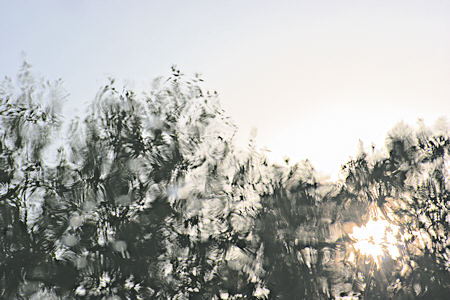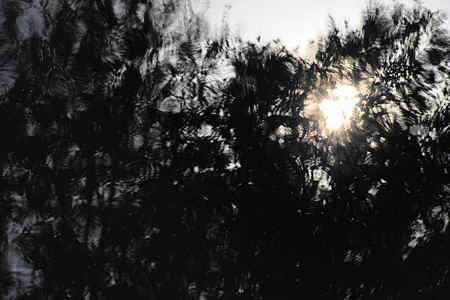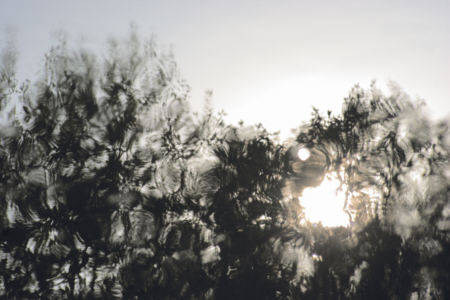
Last week, on my way to somewhere else, I spent a little time wandering in a park and happened on the scene you see above. As you may guess, it is a reflection of trees in a slow-moving stream, which I inverted to present to you as a painterly dreamscape.
A moment later, from the same position, I made the following photograph of the same subject. If the first conjures a dreamy impression, the second may make you rather think nightmare. Why are they so different?

Obviously, the second has a much darker distribution of tones. Not only does that have an emotional impact in itself, but it also hides the detail in the shadows, which could otherwise provide a more airy, open feeling. Furthermore, one feels more hemmed in with the second image simply because there is less sky, less open space to go to.
The picture below is another taken at the same time. To me at least, it seems a more obscure and confusing place, both psychologically and in the world.

None of these images is manipulated, except in ways that all photographs are: exposure, contrast, etc. Do they all record what a place looked like at a particular moment? Which place is it?

Everything is always changing, nothing is permanent.
Your photos remind me of Monet’s paintings of haystacks as he tried to capture light at different times of the day.
Perception is oftentimes stronger than the artist’s intention. Why did you perceive the second image as nightmarish? To me it almost looks like sunlight shining through primeval fronds of a carboniferous swamp (if I were not given the context of the stream). Nice pictures…
Fascinating patterns!
Did you also capture the motifs with different shutter speeds and apertures?
If yes, how did the patterns change?
Sunil,
The characterization as “nightmare” is subjective, of course. But I suspect that as a background for opening movie credits, the first would more likely be a romantic comedy, the second more a dark drama or even horror picture.
Tree,
Your statement is correct, but actually I did not notice any change in the light or the scene over the minute or so I was taking pictures (though of course there were slight changes).
I was pressed for time when I wrote this, and the point is not very clearly developed that the different emotional impacts are influenced by the photographer’s choices. A simple record of the scene simply does not exist.
Steve,
Terrific. Glints. They are sort of Real watercolors. Video?
Steve:
May I suggest “Through The Glass Darkly” by Ingmar Bergman for the second image.
I thought first “waterbugs” when I saw that surface, but it reminds me more of the turbulence associated with a spring. Moreover, it might be that trout of yours, wending its refracted and unseen way.
D.,
Thank you, I love “Real watercolors.” The idea of video has been mentioned before, but though it makes sense in principle, I’m embarrassed to say that the more art video I see, the less I like it. With the exception of your waterfall. I’d appreciate any leads other than Viola. But I think it’s me; for artistic purposes, I’d rather look at a still picture or read a still book and let my mind wander. Narrow, I’m sure.
Jay,
Don’t know that Bergman, but I’ll see if I can get it. The title sure fits.
Steve,
Two Leads:
Rodney Graham’s “How I Became a Ramblin’ Man.” (1999)
Lee Walton’s “One Shot a Day.” (2003)
Steve,
These are interesting, but feel like one-offs to me. I don’t know where to go with them. I’m afraid I yearn for a mysterious narrative or a grand design or a fearsome spectacle –alas, a meaning…….
Capturing the surface, with the tecnical difficulties involved, might be what you are working with. But I’m thinking of Escher’s leaves in a puddle (not it’s name but what I call it) which has all kinds of resonance for me.
http://en.wikipedia.org/wiki/Puddle_(M._C._Escher)
Do they all record what a place looked like at a particular moment? Which place is it?
Steve:
That place where science and Eastern mysticism meet.
Looking again at the images, I see something that I missed before: the sky. The blank ordinariness of the sky with no hint of reflection, allows me to stand the image up into an orientation more akin to ordinary viewing. This way the trees are no longer peered into but more across. As such the dimpling and the puckering become as something alive in the air.
Somehow the term “moment” doesn’t seem to apply anymore than an image of a wave crashing on a shore describes a moment. Technically, yes. But the averaging out as successive, and almost identical, waves crash speaks more to me of the larger context within which the action takes place. So I have to admit, based on the evidence, that I have no idea where or when these images were gathered.